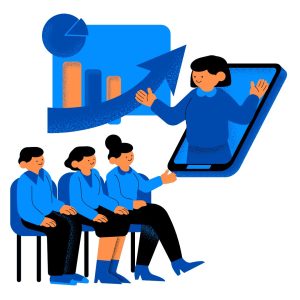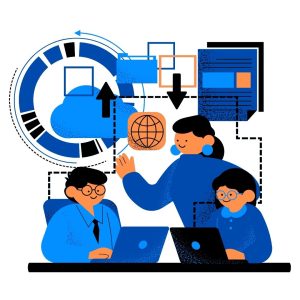March 17, 2025
From Lead to Cash: Understanding the Full Salesforce Lifecycle as an End User
When you’re working in Salesforce every day, it’s easy to focus on your part of the process—whether that’s following up on Leads, sending out Quotes, or checking in on Contracts. But behind every click, there’s a bigger story unfolding.
It’s called the Lead to Cash process, and it’s the full journey your company takes to turn a spark of interest into real revenue. From the first time a potential customer reaches out to the moment payment hits the account, this lifecycle connects nearly every part of the business—and as an end user, you’re right at the heart of it.
The more you understand how Lead to Cash works, the better you can do your job, collaborate across teams, and deliver a seamless experience for your customers. So, let’s take a deep dive into what really happens behind the scenes—and why your role matters at every step.
Step 1: It All Starts with a Lead
 Every customer story begins with a Lead. Whether someone fills out a form, attends a webinar, or replies to a cold email, that initial interest gets captured in Salesforce as a Lead record.
Every customer story begins with a Lead. Whether someone fills out a form, attends a webinar, or replies to a cold email, that initial interest gets captured in Salesforce as a Lead record.
Your job here is more than just entering information. You’re the first touchpoint, gathering the details that will follow this customer through the entire lifecycle. Accurate data—like contact info, company name, and specific needs—sets the foundation for a smooth sales process.
Once you’ve determined they’re qualified to buy, you convert the Lead. With a single action, Salesforce creates an Account, a Contact, and an Opportunity, seamlessly setting the stage for the next phase.
Step 2: Developing the Opportunity
 Now you’re in Opportunity territory—the deal itself. This is where you track every conversation, document the customer’s needs, and map out the path to closing the sale.
Now you’re in Opportunity territory—the deal itself. This is where you track every conversation, document the customer’s needs, and map out the path to closing the sale.
As the deal progresses, updating the Opportunity stages helps everyone stay informed, from sales leadership to customer success teams. Add the products your customer is interested in, log your activities, and set clear next steps to keep momentum going.
A well-managed Opportunity isn’t just good practice—it’s what ensures accurate forecasts, smooth handoffs, and ultimately, a better experience for your customer.
Step 3: Building the Perfect Quote
 When your customer is ready to talk numbers, Salesforce CPQ (Configure, Price, Quote) becomes your best friend. CPQ takes the complexity out of creating quotes, guiding you through product selections, ensuring configurations make sense, and applying the right pricing rules.
When your customer is ready to talk numbers, Salesforce CPQ (Configure, Price, Quote) becomes your best friend. CPQ takes the complexity out of creating quotes, guiding you through product selections, ensuring configurations make sense, and applying the right pricing rules.
What seems like a few simple clicks on your end is actually a sophisticated engine working behind the scenes—validating product bundles, enforcing discount policies, and generating a professional quote document you can send with confidence.
With CPQ handling the heavy lifting, you can focus on delivering a quote that’s accurate, compliant, and tailored to exactly what your customer needs.
Step 4: Turning the Quote into an Order
 Once the customer says yes, the quote transforms into an Order, kicking off the delivery process.
Once the customer says yes, the quote transforms into an Order, kicking off the delivery process.
At this stage, precision is key. The products, pricing, and terms all need to align perfectly with what was agreed upon. Any missteps here can cause delays downstream, so reviewing the order details carefully ensures that everything flows smoothly into fulfillment, delivery, or implementation.
Step 5: Managing Contracts and Renewals
 For subscription products or ongoing services, the Contract becomes your go-to record. It tracks what was sold, for how long, and under what terms.
For subscription products or ongoing services, the Contract becomes your go-to record. It tracks what was sold, for how long, and under what terms.
Keeping Contracts accurate is critical for managing renewals, mid-term changes, and future growth opportunities. When you understand how Contracts work, you can stay ahead of upcoming renewals, suggest upgrades, and make sure your customers get continuous value from your products or services.
Step 6: Billing and Getting Paid
 Finally, everything you’ve worked on comes full circle. The customer receives their invoice, payments are tracked, and the finance team takes it from there.
Finally, everything you’ve worked on comes full circle. The customer receives their invoice, payments are tracked, and the finance team takes it from there.
Even though you might not handle the payment side directly, keeping an eye on invoice statuses and resolving any questions helps maintain a smooth experience all the way through the finish line. And when the cash hits the account? That’s the ultimate sign of a process well executed.
Why Lead to Cash Should Matter to You
Understanding the full Lead to Cash lifecycle isn’t just for admins, finance teams, or sales managers. It’s for anyone who touches Salesforce. Why?
Because when you see the whole picture, you work smarter. You can spot problems before they escalate. You can collaborate better across teams. And most importantly, you help create a frictionless journey for your customers—from their very first conversation to the moment they pay the invoice.
This isn’t just data entry. You’re driving the revenue engine. Every record you update, every field you complete, every quote you send—it’s all part of delivering real business outcomes.
Want to level up your Salesforce game? Start by thinking beyond your daily tasks. Follow a record through the entire Lead to Cash process. See where your work connects with others. Ask questions about what happens before and after your part of the workflow.
The more you understand the full lifecycle, the more value you bring—not just to your team, but to the entire organization.
Written by: Meshach Dimka
Ready to master the full Lead to Cash journey? Start today. Your future self (and your customers) will thank you. Begin your transformation journey today by reaching out to us at bam@dkloudconsulting.com or enquiries@dkloudconsulting.com


